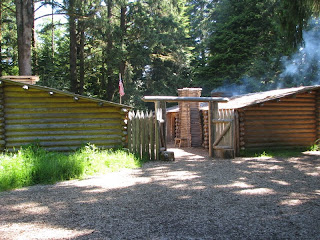May 25, 2024 – Natchez Trace Parkway, AL & TN
Tom knew he needed to do something to honor her memory and during a conversation with an elder of the Yuchi tribe he was told “All things shall pass. Only the stones will remain” which inspired him to build the longest un-mortared wall in the US. The wall is over a mile long and has many seating areas built in – like in this picture. Both sides of the walls were between 5’ to 6’ wide. It was amazing to walk along this tribute to his great-great-grandmother. He also wrote a book about her journey titled: If The Legends Fade.
We crossed the state line back into Tennessee and stopped at another section of The Sunken Trace. At this site there were three cuts made to avoid mud into which oxcarts and wagons sank, making progress slow, dangerous, or even impossible.
We hiked along a couple of these cuts.
Our next stop was Sweetwater Branch which got its name from the clean and fresh, or “sweet” flavor of its water.
We took a short hike through this beautiful area.
The trail followed this creek.
Tacky needed to cool his paws in the creek.
We stopped for lunch at Glenrock Branch and ate our picnic lunch by this balanced rock.
After lunch we stopped at Dogwood Mudhole. A mile to the south the Old Natchez Trace crossed a depression in the flat, dogwood-covered ridge. After heavy rains it became almost impassable for carts and wagons. Its name “Dogwood Mudhole” recalls the ordeals of frontier travel. It shows too how place names arising from local conditions of long ago are carried down through the years.
We turned off on Old Trace Drive where we were able to
drive along 2½ miles of the Old Trace.
This one lane section was paved sometime in the past so our trip was a
lot smoother than in the 1800s – and no mud holes.
It was a beautiful drive.
The next stop was at Metal Ford along the Buffalo River. Around 1820 a charcoal-burning furnace used to manufacture pig iron was located here. We hiked a short trail that took us to the ford site.
Here travelers on the Natchez Trace crossed the
Buffalo River which was fordable except after heavy rains. The ford takes its name from its stone bottom
which reminded frontier travelers of stone-surfaced or “metaled” roads of the
day.
The trail circled around and followed the Mill Race
that once brought water from the Buffalo River to the furnace.
Our last stop of the day was at
Meriwether Lewis. This is the gravesite
of Meriwether Lewis, a Captain in the United States Army, Private Secretary to
President Jefferson, Senior Commander of the Lewis and Clark Expedition, and
Governor of the Territory of Louisiana.
In September of 1809, Meriwether Lewis began his journey to Washington, D.C., to document and defend his spending of government funds, publish the expedition journals, and meet with former President Thomas Jefferson. While traveling, he wrote his will, leaving his possessions to his mother Lucy Marks. He traveled through the remote wilderness along the Natchez Trace north to Grinder’s Stand, an inn run by the Grinder family. Mrs. Grinder prepared a meal that evening and made up a room for Lewis. Later that evening gunshots were heard, and Lewis was found with two gunshot wounds: one to the head, and one to the chest. Lewis’s life ended on the morning of October 11, 1809, at the age of 35. Many who knew Lewis at the time of his death believed he had taken his own life. Recorded circumstances of his death indicate the probability of suicide; however, some accounts dated 1848 and later suggest Lewis may have been murdered. The Grinder House is no longer standing but was located at the site of this museum and information cabin.
The Old Natchez Trace runs beside the
ruins of the Grinder House.
Another long, but enjoyable, day on the Parkway and
now the end is in site as we only have about 58 more miles to go.
.JPG)
.JPG)
.JPG)
.JPG)
.JPG)
.JPG)
.JPG)
.JPG)
.JPG)
.JPG)
.JPG)
.JPG)
.JPG)
.JPG)
.JPG)
.JPG)
.JPG)
.JPG)
.JPG)

.JPG)

Comments
Post a Comment